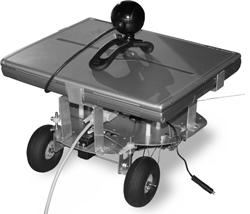Now it is time to build a robotics application with a useful purpose. This chapter will expand on the last chapter by using a modified ARobot, an onboard laptop, and a Web camera to create your very own security monitor robot. You or someone you know might have experience using a Web camera to monitor a home while away. Although it can be quite useful to view images from a Web camera remotely, typically the camera is static and does not move. A Web camera attached to a mobile robot can be moved around an area, thus allowing the observer to change the area being observed.
In this chapter, we will build an application that you can use to operate an ARobot both remotely and by streaming images from a Web camera attached to an onboard laptop. The application will also be used to detect motion and send an e-mail that notifies the owner of the movement. This can be very useful as a security monitor that allows owners to observe areas in their home remotely.
The ARobot, which was introduced in Chapter 7, is a three-wheeled mobile robot available from Arrick Robotics (http://www.robotics.com). This expandable robot allows you to add attachments via pre-drilled holes in the metal chassis. To accommodate the application created in this chapter, you will need to add an onboard laptop (see Figure 8-1). The use of a laptop is necessary because we will be using a USB-enabled Web camera. The camera will be connected to the laptop and not the robot.
Tip
One alternative to using an onboard laptop is to use an embedded personal computer (PC) that runs the Compact Framework. You can purchase an embedded kit that includes all of the software and hardware you will need through the following URL: http://www.embeddedpc.net/ebox2300MSJK/tabid/111/default.aspx.
The cost of the kit is $250 U.S. dollars, and it includes an embedded system built on Vortex86 System-On-Chip technology, with 128 MB system memory, integrated audio, Ethernet, two serial ports, VGA, and 256 MB Integrated Drive Electronics (IDE) bootable flash storage. The Microsoft Robotics Studio (MSRS) team used this kit to create the sumo robot that was used in the Microsoft Mobile and Embedded DevCon (MEDC) 2007. Developers can get more information on how to assemble their own sumo bot from the following Web site: http://msdn2.microsoft.com/en-us/robotics/bb403184.aspx.
The important thing to note in this chapter is that you are not limited to working with what comes in a robotics kit. Most robot kits are expandable and allow you to add sensors or actuators. Additionally, you can assemble your own custom robot using various electronic components. For example, one Microsoft employee from the Windows Mobile development team created his own robot using a smart phone, a LEGO NXT base, and MSRS (see the sidebar titled Profile: Brian Cross).


